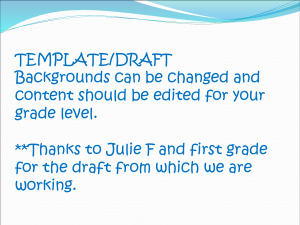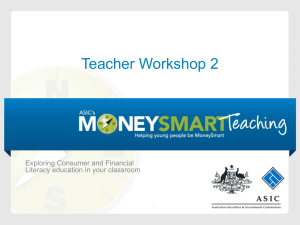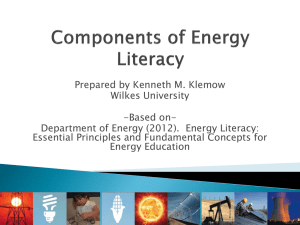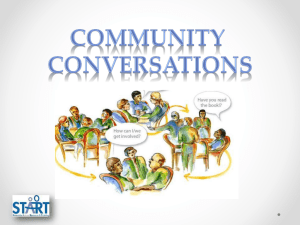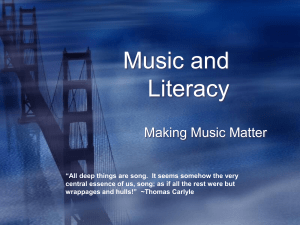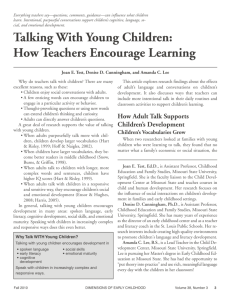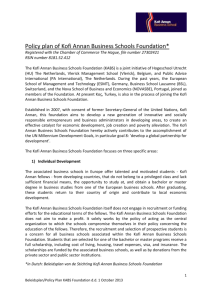Classroom observations of literacy practice
advertisement
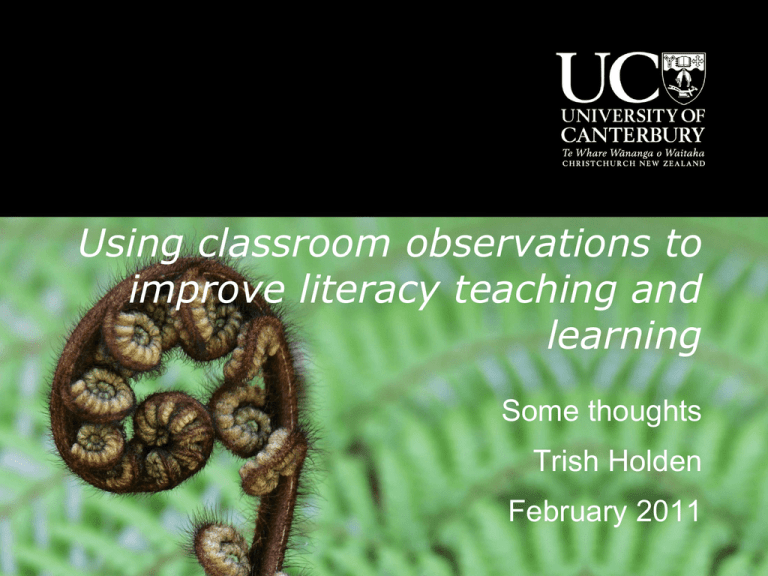
Using classroom observations to improve literacy teaching and learning Some thoughts Trish Holden February 2011 Underlying principles of SLP Principle one: effective teachers have developed expertise Principle two: Effective instructional decisions need to be based on quality evidence and ongoing inquiry Principle three: effective instruction provides a set of optimal conditions for content-area literacy learning. These optimal conditions are described in the guidelines. Ways of improving practice - Eraut Feedback Recording and reviewing Developing awareness of impact Observing Expanding repertoire Why observe? “Classroom or peer observations have to be at the heart of extending or developing teacher repertoires.” [Cooper 1989 cited in Harris, A. School Improvement: What’s in it for Schools] “Classroom observation gives the teachers the opportunity to move from ‘Autonomous Isolation’ to ‘Interactive Professionalism’.” (Wragg1996) How do we learn on the job? What part has classroom observation played in your learning to date? Let’s discuss …positives, minuses, interestings Classroom Observations Can…. Support reflective teaching practice Introduce ‘another pair of eyes’ to the classroom (it can be hard to see or judge your own teaching objectively) Provide some of the evidence needed for evidencebased teaching Help teachers feel safe enough to take some risks Support the professional learning of the observer even more than the observed Woolf Fisher Research Centre The University of Auckland Clarity of purpose Must link the impact of teacher practice on student literacy learning Not about behaviour management Not about content learning But could be about how explicit literacy instruction supported content learning Common purpose and protocols shared and understood by all staff involved cohesion What are my students’ learning needs? What are my learning needs in relation to these? Which of the Guidelines for Effective Adolescent Literacy Instruction would I like feedback on? Pre-observation Discuss student and teacher needs Discuss literacy aspects of lesson Agree on foci of observation –guideline[s]/focus students Timetable a post observation discussion scenario asTTle scores show that students in class are not strong at skimming and scanning Class exercise showed students could not scan page to find definition of keyword even though it was in bold and boxed Teacher admitted that he did not know the difference between skimming and scanning but often told the students to do one or the other Which of the Guidelines for Effective Instruction might you [observer and teacher] chose to focus on? Observer as learner -ako Consider doing observation in pairs Independently record notes post observation discussion – what did you notice, what would you discuss with teacher? Second person can give you feedback on your discussion with teacher. Useful for helping us to learn to analyse classroom practice Recording Have a common template [GEALI] Keep to the agreed foci Note what you see and hear Use clear, unemotive language – don’t evaluate or judge Note points to be discussed, questions to be asked –avoid loaded questions Peer observations Working towards all teachers being able to observe and give feedback on literacy teaching and learning Easier to do this if there is an explicit literacy learning intention Expert content knowledge not needed. Rephrasing the questions Do you think they needed some more support to decode the worksheet? Would it have been better to have done the grouping task in pairs? Rephrase these as open, less judgemental questions Reflection It is not the observation, but the quality of the conversation that counts. What are the characteristics of a quality learning conversation? Engaging in learning talk: the challenges “Teachers politely reinforce each other’s practice regardless of their effectiveness.” PD conversations about teaching and learning not situated in teachers’ own classrooms Conversations focus on issues peripheral to core task of teaching [adapted from Annan, Lai, Robinson] Where Do You Fit? (Robinson, 2002) High Level of Respect Low non-learning conversation (task sacrifice) non-learning conversation (laissez-faire) Low learning conversation non-learning conversation (person sacrifice) High clarity of communication about the business issue Learning talk An inter-related inquiry process Analytical talk [based on evidence] Challenging talk [making changes] Critical talk [evaluating effectiveness] Adapted from Annan, B., Lai, M., Robinson, V. Teacher Talk to improve teaching practices Learning conversations DEER Describe situation and check accuracy with others Explain including factors and values that have produced the situation. Check accuracy Evaluate situation using agreed framework Recommend improvements based on agreed evaluation that will better achieve agreed goal. Useful resource Improving learning for All: learning from the Literacy Professional Development. Effective facilitation: Understanding and Improving Learning conversations with teachers http://literacyonline.tki.org.nz/LiteracyOnline/Interact2/Literacy-Online-update/LPDP

